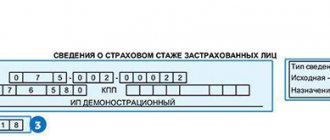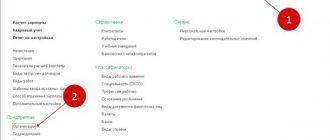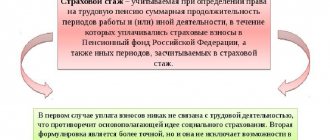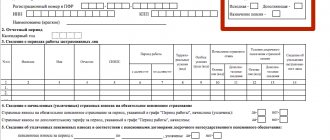Procedure for filling out SZV-STAZH
Filling out the information begins by selecting the type of form to be submitted.
Type "Original"
is filled in when submitting primary information for the reporting period for all insured persons.
Type "Complementary"
is submitted to those employees for whom data, presented in the form with the
“Initial”
, was missing or not included in individual personal accounts due to an error contained in them.
Type “Pension assignment”
is presented to insured persons who retire this year.
When the reporting deadline arrives, these individuals must also submit a form with the “Original”
.
Attention! SZV-STAZH with the “Pension Assignment”
is created in the Pension Fund register
“For Retirement”
.
To generate information, you must select an employee using the “+ Employee”
. The employee is selected from the list, and if he is absent, he is added using the “+” button, filling in all his personal data (full name, SNILS, INN, date of birth, passport data, etc.).
Next, click on the “Operation period”
the periods of work of the insured person are indicated.
Moreover, these periods should not extend beyond the reporting period. If the date of dismissal of this employee falls on December 31 of the calendar year for which information is being submitted, then a mark is made in the “Dismissed on December 31”
.
in the “Unemployed”
if it is necessary to indicate the periods that are included in the insurance period for the unemployed.
Individual fields also indicate periods when the employee not only worked, but was also on vacation, sick, etc. To do this, in the “Additional” block.
information and preferential length of service" in the
"Additional" field.
information: sick leave/children/vacation”, select the code for the corresponding period.
Attention! When reflecting several periods of work for a specific employee, each period is indicated separately, incl. and if the employee quit during the year and was rehired.
Attention! For a form with the type “Pension assignment”
The employee's periods of work are indicated up to the date preceding the date of expected retirement.
Attention! The period of work of the insured person within the framework of a civil contract is filled in and reflected in the “Additional” field. information: sick leave/children/vacation"
one of the following codes:
- “AGREEMENT” - if payment under the agreement was made in the reporting period,
- “NEOPLDOG” or “NEOPLAVT” - if payment was not made.
Attention! If in the field “Add. information: sick leave/children/vacation"
If you need to indicate more than one code at the same time, one of which indicates the filling of state or municipal positions, then such information is indicated in two lines. In this case, the first line always indicates the periods with the codes: “ZGDS”, “ZGD”, “ZGGS”, “ZMS”, “ZMD”. The second line reflects the period with a different additional information code, which must be inside the period or equal to the period specified in the first line.
In the "Territorial conditions"
the code of the territorial conditions in which the employee works is indicated.
Attention! If an employee works full-time in a part-time mode, then the period of work is reflected according to the actual working time worked (field “Output in months (hours)”
);
if in part-time mode, then, accordingly, the volume of work is reflected (field “Rate”
) in a given period.
Field "Special working conditions"
is filled out in relation to insured persons working under conditions that give the right to early assignment of a pension.
Attention! This field is filled in only if, during the period of work under conditions that give the right to early assignment of a pension, insurance contributions at an additional rate or contributions in accordance with pension agreements for early non-state pension provision have been paid.
If the employee was employed in work with harmful or difficult working conditions, then the code of the employee’s profession is additionally indicated in the “List Position Code”
.
Fields “Special working conditions”
,
“Early assignment of pension”
are not filled out if:
- special working conditions are not documented;
- the employee’s employment in special conditions does not comply with the requirements of current regulatory documents;
- There is no payment of insurance premiums at an additional tariff or contributions in accordance with pension agreements for early non-state pension provision.
In the field "Insurance experience"
the basis for calculating the insurance period is selected, and the actual time worked is indicated in the corresponding fields - the number of calendar months and days (for divers - the time spent under water in hours and minutes).
Attention! In the field "Insurance experience"
the code “VIRUS” is indicated in relation to medical workers who provided medical care to patients with COVID-19 or suspected of it.
This code is indicated if
codes 27-1, 27-2 and (or)
“Early assignment of pension”
“Special working conditions” - 27-GD, 27-SM, 27-GDHR, 27-SMHR.
It is also necessary to take into account that if the code “VIRUS” is indicated in the “Insurance Experience
, then in the
“Special Working Conditions”
code 27-1 must be indicated in combination with codes 12300000-17541, 12300000-20426, 12300000-24577, 12300000- 24713 or code 27-2 in combination with codes 2260000a, 2260000b, 2260000e, 2260000zh, 22600000-1754v, 22600000-14467.
Attention! For SZV-STAZH with the “Pension Assignment”
information is reflected on insurance premiums accrued for compulsory pension insurance (OPI), incl. at additional rates. If an employee applying for a pension was accrued insurance premiums for the periods of work specified in the information, then marks are made in the appropriate fields.
Section “Information on paid contributions under early non-state pension agreements”
is filled out only in information with the
“Pension Assignment”
and is intended for those policyholders who have an agreement with the Non-State Pension Fund on early pension provision for workers engaged in hazardous work. To fill out the section, you must click on the “+” button and in the appropriate fields, check whether the contributions have been paid and indicate for what period of the employee’s work.
What data goes into SZV-STAZH
SZV-STAZH is a form of annual reporting on the length of service of employees, used starting with the report for 2021 (Resolution of the Board of the Pension Fund of the Russian Federation dated December 6, 2018 No. 507p).
The need for its appearance was caused by the abolition of the previously used quarterly form RSV-1, which was submitted to the Pension Fund of the Russian Federation and contained information on the calculation and payment of insurance premiums for compulsory health insurance, as well as information on length of service. Since 2021, control over the calculation and payment of contributions has passed to the tax authorities; quarterly reports began to be submitted there, combining data on accruals for all insurance premiums transferred to the jurisdiction of the Federal Tax Service (OSI, compulsory medical insurance, compulsory social insurance, except for contributions for injuries). This reporting also includes a section with information about accrual of payments to compulsory pension insurance made in relation to the income of each employee personally.
However, information about the length of service was not included in the new reports submitted to the Federal Tax Service as it is not related to the calculation and payment of contributions. Control over data on length of service remained with the Pension Fund of Russia, but the submission of information about it became annual. It is for this annual reporting that a new reporting form (SZV-STAZH) was introduced.
The form reflects information about the policyholder (name, registration number, TIN, KPP), the type of information submitted (initial, supplementary, intended for calculating a pension) and the year for which the report is submitted. To enter basic information (about the length of service of employees), there is a table reflecting the information:
- about full name and SNILS of employees (columns 2–5);
- the period of their work for the reporting year (columns 6–7);
- working conditions and periods specially taken into account in the length of service (columns 8–13);
- the fact of dismissal on December 31 of the reporting year (column 14).
Under the table there are sections for marks indicating the fact of accrual and payment of contributions, which are required to be filled out only when submitting information about the length of service for calculating a pension.
The SZV-STAZH form can be downloaded here.
Section 2. Reporting period (code)
This section automatically indicates the code of the reporting period for which the information is provided.
A separate field indicates the type of form being presented.
Type "Original"
filled out to accompany a package of documents with personalized accounting forms.
Attention! The package may include documents of only one name and one type of information, and for a package of SZV-ISH forms - one name, one type of information and for one reporting period.
Key filling rules
New reporting to the Russian Pension Fund became mandatory only in 2021. Now insurance companies are required to report annually on all employees and specialists who worked during the reporting period.
Let us remind you that the report in the SZV-STAZH form is generated based on information for 2021. We talked about which form to use, when to submit it and how to correctly fill out the information in the reporting form in a separate material, “Filling out and submitting the SZV-STAZH form to the Pension Fund of Russia.”
IMPORTANT!
In 2021, use the form approved by Resolution of the Board of the Pension Fund of the Russian Federation dated December 6, 2018 No. 507p.
Let's take a closer look at the situation of how to fill out the SZV-STAZH when on vacation at your own expense.
Section 4. Data on the policyholder
The section is completed if EDV-1 is submitted simultaneously with the SZV-ISH forms or with the SZV-KORR form with the “Special”
.
The following indicators are indicated in the corresponding columns:
- debt at the beginning and end of the reporting period;
- the amount of accrued and paid insurance premiums.
Attention! These data are reflected separately in relation to insurance premiums for insurance and funded pensions, as well as according to the tariff. A separate table provides a breakdown of the insurance premiums paid by the periods for which the premiums were paid.
How to draw up and submit SZV-Experience for a retired employee
When dismissing an employee due to retirement, the employer draws up and submits a SZV-Senior report, which includes information only on the dismissed employee.
Detailed instructions for filling out and submitting a report to the Pension Fund are presented below.
Step 1. We receive a statement from an employee
An employee of pre-retirement age applies to the organization’s HR department with a resignation letter due to retirement - this fact is a direct basis for the employer to prepare and submit a report to the Pension Fund ahead of schedule.
Before starting the termination procedure, make sure that the employee actually acquires the right to a pension. In 2021, the following requirements have been established for applying for an old-age insurance pension:
- Retirement age . From 01/01/2021, the procedure for gradually increasing the retirement age begins. In 2021, citizens acquire the right to a pension at 61 years of age (men) and 56 years of age (women). Moreover, in 2021 – 2021. You can apply for a pension early - 6 months before retirement age.
- Insurance experience . To apply for a pension in 2021, the minimum length of service of an employee must be 10 years, in 2021 - 11 years.
Thus, in 2021, an employee can resign due to retirement, provided that he is 60.5 years old (men) or 55.5 years old (women), and his insurance period is at least 10 years.
Step #2. Filling out the SZV-Experience
When preparing the SZV-Stazh “pension” report, use the standard annual form. In the form type column, put o. Include in the report only data on the departing employee for the reporting period (current calendar year).
The table below provides a detailed description of the procedure for filling out the report:
| Section of the SZV-Experience report when assigning a pension | How to fill | |
| number | Name | |
| 1 | Information about the policyholder | Provide information about the organization (IP):
|
| 2 | Reporting period | Indicate the current calendar year (based on the date the application was received). |
| 3 | Information about the periods of work of the insured persons | Provide information about the resigning employee:
|
| 4 | Information on accrued (paid) insurance contributions for compulsory pension insurance | In the form of marks in the appropriate fields, indicate information about the payment of insurance premiums for the employee to the Pension Fund of the Russian Federation at the basic and additional rates (“yes” - contributions have been paid in full, “no” - not paid or not paid in full). |
| 5 | Information on paid pension contributions in accordance with pension agreements for early non-state pension provision | Complete the section if the employee was engaged in hazardous work, as well as if the employee has an agreement with a non-governmental pension fund. Data to fill:
|
If the average number of employees is 25 or more, then the report must be submitted electronically. In other cases, the employer independently chooses the most convenient form of reporting – paper or electronic.
When preparing a document on paper, the report is signed by the manager, after which the document is affixed with the seal of the organization. The electronic form of the report is signed with an electronic digital signature key.
Step #3. Compiling EDV-1
The preparation of the SZV-Experience report when assigning a pension is accompanied by the preparation of an inventory in the EDV-1 form.
To compile the inventory, a standard form is used indicating the form type “outgoing” and the reporting period code “0” (current calendar year).
In the column “Information about the insurance experience of insured persons (SZV-STAZH)” indicate “1 employee”. Next, provide information about:
- the amount of accrued and paid insurance premiums for the insurance and funded pension of the resigning employee (including the tariff, the amount of debt at the beginning and end of the current year);
- the amount of insurance premiums paid for the insurance/funded pension, broken down by tariffs;
- periods of work granting the right to early retirement (nature of work, code of special conditions according to the Classifier).
Similar to the procedure for submitting SZV-Experience, the EDV-1 inventory is submitted exclusively in electronic form if the average number of employees in the organization is at least 25 people.
Step #4. Submitting a report to the Pension Fund
The SZV-Experience report when assigning a pension (together with the EDV-1 inventory) must be submitted to the Pension Fund of the Russian Federation no later than the 3rd day following the day of receiving the resignation letter from the employee.
You can submit documents to the Pension Fund:
- in person (application to the Pension Fund of the organization by the head of the organization or a representative acting on the basis of a notarized power of attorney);
- by mail (sending a package of documents by registered mail with notification and a list of attachments);
- in electronic form (drawing up an electronic report form, signing with an electronic digital signature key, sending to the Pension Fund via telecommunication channels).
The date of submission of the report is considered:
- date of application to the Pension Fund - in case of personal application or submission of documents through a representative;
- date of receipt indicated in the notification spine - when sending documents by mail;
- date of the electronic receipt from the Pension Fund of the Russian Federation – when preparing an electronic report.
How to reflect vacation periods with the code “DLOTPUSK” in SZV-STAZH?
In the SZV-STAZH form for 2021, the “DLOTPUSK” code is filled in only for periods of employee work under special working conditions, for which insurance premiums were not charged at additional rates. For employees who were on annual paid leave and at the same time working under normal working conditions, this code does not apply.
The code “DLOTPUSK” must also be used in the case when the employee was on regular vacation in January, received vacation pay in December, and quit his job on the last day of vacation, and no contributions were accrued to him in the current calendar year.
Basic codes for calculating length of service in 2020
Selecting the required code for columns 8 (according to territorial conditions), 9 (for special conditions), 10 (for special periods included in the length of service) and 12 (for conditions giving the right to early retirement) does not present any particular difficulties, since each of these the graph corresponds to its own single table.
Including the table in the appendix, the codes for column 10 SZV-STAZH “Calculation of insurance experience, basis (code)” are clearly interpreted, for which there are no explanations in the text of the procedure for filling out the form. From the table dedicated to them, it becomes clear that work periods require reflection here:
- in seasonally operating industries (SEASON);
- in the field (FIELD);
- in places of deprivation of liberty (PEC 104);
- under water (DIVER);
- in special medical institutions (LEPRO).
The tables relating to the above columns can be viewed in full on our website:
- to column 8 - codes of territorial conditions used when filling out the forms “Information on the insurance experience of insured persons (SZV-STAZH) ...”;
- to column 9 - codes of special working conditions used when filling out the forms “Information on the insurance experience of insured persons (SZV-STAZH) ...”;
- to column 10 - codes “Calculation of insurance experience: basis”, used when filling out the forms “Information on the insurance experience of insured persons (SZV-STAZH) ...”;
- to column 12 - codes “Conditions for early assignment of an insurance pension: basis”, used when filling out the forms “Information on the insurance experience of insured persons (SZV-STAZH) ...”.
The total number of tables corresponding to absence period codes reaches three. What is the reason for such a number of tables, each of which, unlike, for example, those related to columns 9 and 12, is not voluminous? Why aren't they combined into one?
This decision is explained by the fact that two of them relate to employees (registered both under an employment contract and under GPC agreements) and should be used when drawing up SZV-STAZH. Their division into different tables is caused by the indication in one of them of periods of absence included in the length of service, and in the other - those not included in it.
To learn about the conditions under which periods of absence are included in the insurance period, read the material “What is the insurance period for a pension.”
The third table is devoted to the periods taken into account in the length of service of self-employed persons who, during these periods, are not able to pay insurance premiums for themselves. Since self-employed persons do not submit reports on their work experience, the absence codes indicated in this table in SZV-STAZH are not used.
Thus, to fill out column 11, codes will have to be selected based on their meanings contained in two tables in the appendix to the procedure for filling out forms, approved by Resolution of the Pension Fund Board No. 507p.
See also the Checklist for filling out the SZV-STAZH for 2019.
How to correct mistakes when taking SZV-STAZH?
During the submission of information about experience, various errors may occur, which are indicated in the protocol by certain codes. To correct these errors, you must submit a clarifying report form.
The procedure for correcting errors, depending on their type and whether the report was accepted by the fund, is presented in the following table:
| Error made in the report | How to fix the error |
| Incorrect registration number of the policyholder in the Pension Fund of the Russian Federation, incorrect TIN, etc. (error code – 50) | Resubmit SZV-STAZH with the “Initial” type within 5 working days from the date of receipt of the protocol |
| Inaccurate information regarding insured persons (for example, errors in full name, SNILS, etc.) (error code - 30 and 40) | Submit SZV-STAZH with the “Additional” type for those persons in respect of whom errors were discovered within 5 working days from the date of receipt of the protocol |
| Inaccurate information regarding insured persons for whom the initial report was successfully accepted (data recorded on personal accounts) | Submit SZV-KORR with the “Corrective” type for those persons in respect of whom errors were detected |
| We included in the original report workers who should not have been included in it, for example, those who were laid off last year | Provide SZV-KORR with the type “About employees |
| Forgot to include workers in the report, for example, contractors or maternity leavers | Present SZV-STAZH with the “Additional” type for “forgotten” employees |
Is it possible to submit SZV-STAZH to a director who is the sole founder?
The founding director is an insured person, regardless of whether a written employment contract has been concluded with him or not and whether he receives a salary. As the Ministry of Labor notes in letter No. 17-4/10/B-1846 dated March 16, 2018, labor relations can arise even when the employment contract is not concluded properly, in particular, on the basis of the actual admission of the employee to work with the knowledge or on behalf of the employer . Thus, if the organization has only one director, who is the sole founder, then it is necessary to fill out a SZV-STAZH for him.
SZV-Stazh report: what? Where? When?
The procedure for drawing up and submitting the SZV-Stazh report is regulated by Resolution of the Board of the Pension Fund of the Russian Federation No. 3p dated January 11, 2017. In accordance with the documents, the report is submitted by all employers (both individual entrepreneurs and legal entities), regardless of the form of ownership and organizational and legal structure.
The employer reflects in the report information about the employee’s insurance experience for the reporting period (calendar year). The report includes data:
- about employees working on the basis of employment contracts;
- about persons involved in work on the basis of civil process agreements;
- about the director who performs official duties in accordance with a fixed-term employment contract;
- about the liquidator or members of the liquidation commission (if the report is submitted by an organization that is in the process of liquidation);
- about the director who is the sole founder, regardless of the existence of an employment contract.
From 01/01/2021, the SZV-Stazh report is submitted on an updated form. Detailed information regarding the procedure for drawing up and submitting the new SZV-Experience form can be found in the article ⇒ “New SZV-Experience form in 2021: how to compile, submission deadline.”
Employers submit SZV-Experience to the territorial body of the Pension Fund of the Russian Federation at the place of registration (for individual entrepreneurs - at the place of residence) annually before March 1 of the year following the reporting year.








